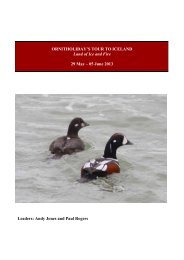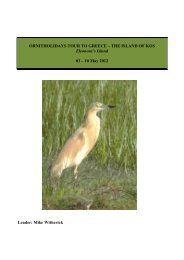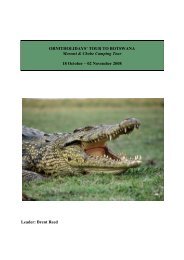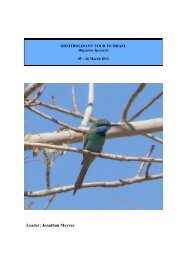Download 2014 Brochure (.pdf) - Ornitholidays
Download 2014 Brochure (.pdf) - Ornitholidays
Download 2014 Brochure (.pdf) - Ornitholidays
Create successful ePaper yourself
Turn your PDF publications into a flip-book with our unique Google optimized e-Paper software.
S PA I N<br />
Spain – Coto Doñana & Extremadura<br />
Spring Tour<br />
Sunday 06 April – Sunday 13 April <strong>2014</strong><br />
Principal Leader: Steve West<br />
<strong>2014</strong> Cost: £1,599 single room supplement £140<br />
SPAIN<br />
his tour allows us to explore these two rich and contrasting areas. The Coto Doñana is justifiably<br />
T famous as one of the major wetlands in Europe. The area around Matalascañas, El Rocío and<br />
Almonte is a superb complex of open water, reed bed, sand dune and mixed woodland which<br />
allows a highly diverse range of species to survive here. Spanish Imperial Eagle, Purple Swamphen,<br />
Marbled Duck (now scarce), Azure-winged Magpie and Red-necked Nightjar all breed in this area, and<br />
the whole region acts as a staging post for an enormous number of migrant waders and passerines on<br />
their journey northwards at this time of year. Extremadura holds one of Spain's most interesting national<br />
parks – Monfragüe. It is one of the best sites for seeing Eurasian Black Vulture and Black Stork. The grasslands of this region are threatened by modern<br />
agricultural methods, but large areas still remain untouched and we shall be able to enjoy views of both Great and Little Bustards and with luck both<br />
Pin-tailed and Black-bellied Sandgrouse. <strong>Ornitholidays</strong> possesses unrivalled experience in these areas of Spain and we have been running tours here<br />
since the 1960s.<br />
Torrejón<br />
el Rubio<br />
Seville<br />
Villamanrique<br />
de la Condesa<br />
ITINERARY<br />
Madrid<br />
Days 1 to 4<br />
In the morning we fly from London to Madrid.<br />
We pick up our minibuses and drive to our hotel<br />
on the edge of the National Park of Monfragüe,<br />
where we stay for four nights.<br />
Uppermost on our list of priorities will be a visit<br />
to the Monfragüe National Park, where the<br />
rocky, scrub-covered slopes and steep river<br />
valleys allow rich hunting for a few pairs of<br />
Spanish Imperial as well as Golden Eagles, and<br />
the cliffs hold nests of Black Stork. The rocky<br />
crag of Penfalcón will allow us to watch<br />
squadrons of Eurasian Griffon Vultures<br />
(interspersed with the smaller Egyptian and the<br />
larger Eurasian Black) patrolling the skies.<br />
Further on, El Portillo del Tiétar is a well known<br />
spot for the powerful Eurasian Eagle Owl,<br />
nesting pairs of Black Stork, and rock-loving<br />
birds such as Blue Rock Thrush and Rock<br />
Bunting. The whole park is a superlative site for<br />
raptors and, if the weather conditions are right, it<br />
is possible to see all five Spanish eagles in a<br />
single day – Spanish Imperial, Golden, Booted,<br />
Short-toed and Bonelli's!<br />
The beautiful town square of Trujillo still looks<br />
much as it must have done when the<br />
Conquistadors built their palaces here. Lesser<br />
Kestrel soar overhead and White Storks attend<br />
their rooftop nests and small numbers of Pallid<br />
Swift mingle with the more abundant Common<br />
Swift. Trujillo is also well located for exploring<br />
the surrounding grasslands and mountain<br />
ridges, as well as the Cork Oak dehesa, which is<br />
lightly wooded, savannah-like country. This is<br />
the habitat where we should find Great Spotted<br />
Cuckoo, Spanish Sparrow, Woodchat Shrike,<br />
Azure-winged Magpie and Orphean Warbler,<br />
among others.<br />
Purple Swamphen<br />
To the east and west of Trujillo lies the more<br />
open steppe, where we hope to see Great<br />
Bustard displaying, looking not unlike a pile of<br />
snow on sticks! Little Bustard will also be in<br />
breeding plumage and in addition there are Pintailed<br />
and Black-bellied Sandgrouse, Stone<br />
Curlew and European Roller. Montagu's Harrier<br />
patrol the cultivated fields, Red-rumped Swallow<br />
hawk the insects, and White Stork are<br />
everywhere - feeding on the steppe, following<br />
ploughs, nesting on trees, farmhouses and<br />
pylons.<br />
102<br />
For a previous tour report or further information please call: 01794 519445








